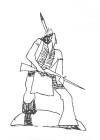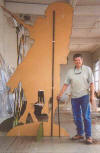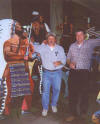| Friends Of The Little Bighorn Battlefield |
The Next Generation In The Study Of Custer's Last Stand |
Progress of Ross's Project |
| • The Battle • Archeology • Memorials • Little Bighorn Store • News • Book Reviews |
More to See >>
by Bob ReeceAll photos and life-size figures © Thom Ross unless otherwise notedWhen Thom Ross first wrote me about his wild idea of creating life-size figures from plywood of Custer and his soldiers, then actually stand them near the Custer Battlefield I knew the man was serious. "The soldiers would face life-size figures of Crazy Horse, Lame White Man and many warriors..." he said (all together 200 + plus figures). These simple figures are a modern but most unique approach for interpreting Custer’s Last Stand. No other artist but Thom Ross could get away with this concept and make it work. There have already been general complaints from historians that Ross has taken dramatic artistic license with the figures’ designs; they’re not accurate, the soldiers were not dressed that way, the warriors didn’t look like that – the list goes on and on. Yet, these same people find pleasure in watching Errol Flynn's, "They Died with Their Boots On" -- a film whose subject isn't close to anything historically accurate, yet it influenced all of them to learn more about Custer and the Battle of the Little Bighorn. So, Ross is finding a way to do the same for a new generation. The artist, Thom Ross standing next to some of his figures
They’re missing the whole point of Ross’s project. Ross doesn’t believe it’s necessary to get every bit of detail in a painting accurate and he doesn’t believe that every historical artist needs to – there are plenty of good ones out there that do that very well (Eric von Schmidt and Martin Pate – our other resident artists do just that). What art does best is convey emotion, create interest, ask questions, and spark imagination. It’s a fantastic medium to draw attention to the Custer story, which includes life as an Indian on the vast American plains of the 19th century, soldiers marching hundreds of miles through thunderstorms, across raging rivers, and under the blazing heat of the sun only to meet an untimely death. Thom Ross’s plywood figures will light the flame and spark people’s interest about the Battle of the Little Bighorn. What more can we ask for than that?
The ProcessMr. Ross sketches a small likeness of the figure...
He then projects it on the wall until it's at the size he wants, followed by outlining it on paper. He then transfers the sketch to a piece of plywood and cuts it out.
Once the figure is cut then sanding is in order. Below is the artist's daughter, Olivia doing her part.
Fine sanding is also required.
The figure is now ready for painting.
This is what the warrior looks like completed.
How do the figures remain standing once they're put into place? They do have a base, but Mr. Ross has developed a smart way to brace the figure up and keep it that way even during one of Montana's famous thunderstorms.
This is Guy
Watkins holding a three foot long spike which gets driven into the
ground. On the back side of the figure (in this photo it is a 10 foot
tall mounted Indian) you will see a long, black pipe attached to the
figure. This pipe is set over the part of the spike protruding from the
ground. The artist (L) and friend, Guy Watkins (R)
Custer
Crazy Horse
Two Moons
Gall
Curly
Crow King
Soldiers
Misc Figures
Trial Run -- May 17, 2004Mr. Ross placed five figures on a windy hillside outside of Ellensburg, WA to test the support system. The experiment went without a hitch. In a letter to me, addressing the photo below, Mr. Ross stated, "We placed the figures on the hillside and set two flags in the group. The flag with the soldier on the right is a plywood flag which will not move in the wind. However, the other two flags (a striped troop guidon and Custer's personal battle flag with two crossed swords) snapped to attention immediately. The large mounted Indian warrior took the most abuse due to his enormous size and area. We found it was very easy to rotate the figures so that (1) they could be aligned with the movements of the sun, and (2) we can always keep a cutting edge of the figures set into the wind to minimize the winds effect on the figures."
The First Last Stand -- June 11, 2004In an email Mr. Ross stated, "They looked GREAT on the
hillside....and then the weather set in and it stormed all night; rain,
sleet, wind, and freezing temperatures. BUT, we got some decent photos
and the figures survived the pounding storm all night. Only one toppled
over and when I went to check on them at 4 in the morning I wandered
amongst the fighting figures with only the driving wind and the flapping
of the flags; very eerie. It all went well, although we were disappointed in the
weather....we weren't able to photograph the pieces at dawn as it was
STILL nothing but ice cold wind and rain buffeting the landscape. We
packed up and ran for home to dry out."
June 11, 2004
February 5, 2005When I returned yesterday from my weeklong stay at the battlefield I found recent photos of Thom Ross’s figures in my email box -- The changes Thom has made to the figures are awesome, powerful, more life like. See Kellogg for instance; Thom has captured him at the moment he meets his maker. The life long dream Thom has held for this project is finally coming to reality. He’ll be placing the 200 plus figures of soldiers and warriors along the Little Bighorn River at Medicine Tail Ford from June 23-26, 2005. Thom has promised the Friends of the Little Bighorn Battlefield one of the figures (don’t know yet if it will be an Indian or a soldier) to auction as a fundraiser. We’ll either auction it here or on EBay – date still to be determined. This is a most generous offer by the artist and is very much appreciated. We’ll continue to update our viewers of this project here at the Friends’ website. Thom Ross Home |
|
Copyright 1999-2013 Bob Reece Friends Little Bighorn Battlefield, P.O. Box 636, Crow Agency, MT 59022 | Home |
Board of Directors |
Guest Book | Contact | Site Map
| |


















































